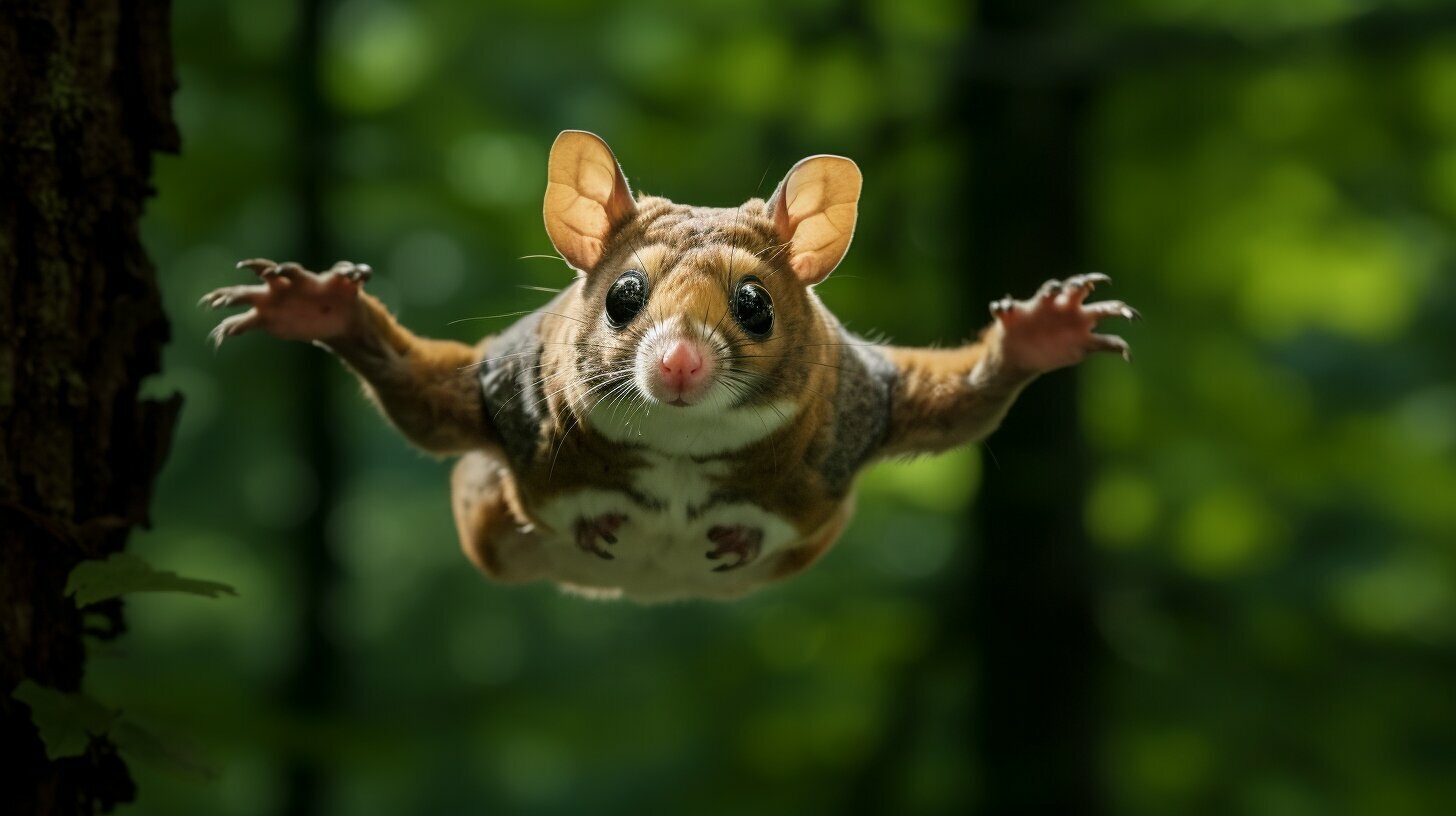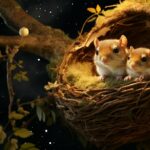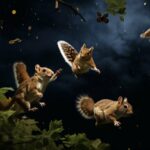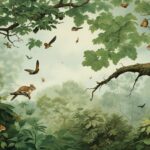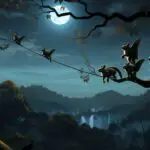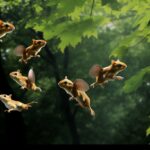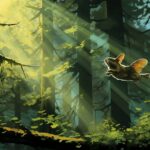Flying squirrels are captivating creatures with unique lifespans that are worth exploring. These furry acrobats are known for their gliding ability, soaring through the air using a furry membrane called the patagium. They can glide anywhere from 150 to 500 feet, making impressive 180-degree turns to evade predators. With about 50 species found in North America, Central America, Asia, and Scandinavia, flying squirrels come in various sizes and have diverse diets. Some species feast on insects, seeds, nuts, and fungi, while others have a preference for cultivated fruit.
Reproduction among flying squirrels also varies. Some species have one mating cycle per year, while others have two. In terms of offspring, some are born blind, hairless, and helpless, requiring significant care from their parents. Others are more developed at birth, starting their journey with a head start. They make their homes in woodpecker holes, abandoned nests, and tree cavities, thriving in forests, woodlands, and jungles.
While flying squirrels possess remarkable abilities and adaptations, their lifespans in the wild are relatively short, typically less than four years. These fascinating creatures face threats such as habitat destruction and hunting, which contribute to their limited longevity. However, some species, like the southern flying squirrel and Javanese flying squirrel, have managed to maintain stable populations.
In specific regions, such as Pennsylvania, northern flying squirrels are endangered due to habitat loss and a decline in their food sources. Despite these challenges, flying squirrels play an essential role in ecosystems. They contribute to forest regeneration by dispersing spores of fungi and serve as prey for various predators, supporting a delicate balance in the natural world.
Key Takeaways
- Flying squirrels possess a unique gliding ability and can make impressive 180-degree turns in the air.
- There are about 50 species of flying squirrels found in North America, Central America, Asia, and Scandinavia, with varying sizes and diets.
- Reproduction and offspring characteristics can vary among different species of flying squirrels.
- Flying squirrels live in woodpecker holes, abandoned nests, and tree cavities in forests, woodlands, and jungles.
- While their lifespans in the wild are typically less than four years, some species, like the southern flying squirrel and Javanese flying squirrel, have stable populations.
Understanding the Lifespan of Flying Squirrels
If you’ve ever wondered how long flying squirrels can live, you’re in for an interesting discovery. These fascinating creatures, known for their gliding ability, have a lifespan that varies depending on several factors. On average, flying squirrels live for about 5 to 6 years in the wild, although some individuals have been known to reach up to 10 years of age.
Several factors contribute to the lifespan of a flying squirrel. Genetics, environmental conditions, and predation risks all play a role in determining how long these adorable creatures can live. Additionally, the availability of suitable habitats and food sources can have a significant impact on their longevity.
It’s important to note that different species of flying squirrels may have varied lifespans. For example, the northern flying squirrel, found in North America, typically lives for about 4 to 6 years. On the other hand, the southern flying squirrel, known for its adaptability, may live up to 8 years. The lifespan of the Javanese flying squirrel, found in Southeast Asia, ranges from 7 to 10 years.
While the lifespan of flying squirrels may seem relatively short compared to some other small mammals, they still play a vital role in their ecosystems. Their gliding abilities help disperse the spores of fungi, contributing to forest regeneration. Additionally, they serve as prey for various predators, ensuring a balanced food chain.
| Flying Squirrel Species | Average Lifespan (in the wild) |
|---|---|
| Northern Flying Squirrel | 4-6 years |
| Southern Flying Squirrel | 6-8 years |
| Javanese Flying Squirrel | 7-10 years |
In conclusion, the average lifespan of a flying squirrel is around 5 to 6 years in the wild, although this can vary among different species. Understanding the factors that affect their lifespan, such as genetics, environment, and predation risks, provides valuable insights into these enchanting creatures’ lives. While their time may be relatively short, flying squirrels contribute to the balance and regeneration of their ecosystems, making them an integral part of our natural world.
Factors Affecting Flying Squirrel Lifespan
The lifespan of a flying squirrel can be influenced by several factors that determine their survival in the wild. These factors include habitat availability, food availability, predation, disease, and reproductive success.
Habitat availability: Flying squirrels require suitable habitats, such as forests, woodlands, and jungles, with ample tree cavities, abandoned nests, or woodpecker holes for shelter. Deforestation and habitat destruction pose significant threats to their lifespan, as these squirrels rely on specific environments for protection and nesting.
Food availability: Different species of flying squirrels have varying diets, including insects, seeds, nuts, fungi, and cultivated fruit. The availability of these food sources directly impacts their survival. Changes in vegetation, loss of food-bearing trees, or agricultural practices that reduce access to food can significantly affect their lifespan.
Predation and disease: Flying squirrels face predators such as owls, snakes, raccoons, and domestic cats. Their lifespan can be shortened by predation, as these predators perceive them as a food source. Additionally, diseases, such as parasites or infections, can weaken their immune systems and decrease their chances of survival.
Reproductive success: The ability of flying squirrels to reproduce and raise offspring also influences their lifespan. Factors such as mating success, litter size, and parental care can impact their overall survival rates. Some species have one mating cycle per year, while others have two, and the level of parental investment varies among species.
In summary, the lifespan of flying squirrels is influenced by various factors, including habitat availability, food availability, predation, disease, and reproductive success. Protecting their habitats, maintaining healthy ecosystems, and minimizing threats such as deforestation and predation can play a crucial role in ensuring the survival of these fascinating creatures in the wild.
| Factors Affecting Flying Squirrel Lifespan |
|---|
| Habitat availability |
| Food availability |
| Predation and disease |
| Reproductive success |
Diverse Species and Their Lifespans
Flying squirrels come in various species, each with its own distinct lifespan and adaptations. From the charismatic northern flying squirrel to the elusive Siberian flying squirrel, these remarkable creatures display a range of lifespans that add to their fascinating nature. Let’s explore some of the different species and their unique characteristics.
Northern Flying Squirrel
The northern flying squirrel (Glaucomys sabrinus) is a small nocturnal species found in North America. They have a lifespan of up to 6 years in the wild, making them one of the longer-lived flying squirrel species. With their large eyes and soft fur, they are well-adapted for life in the boreal forests, where they glide gracefully between trees in search of food.
Southern Flying Squirrel
The southern flying squirrel (Glaucomys volans) is another North American species known for its acrobatic gliding abilities. These adorable creatures have an average lifespan of 4 to 6 years in the wild. They are social animals and often form small groups, huddling together to stay warm during the colder months.
Siberian Flying Squirrel
The Siberian flying squirrel (Pteromys volans) is native to Asia and is the largest species of flying squirrel. It has a lifespan of up to 10 years, making it one of the longest-lived flying squirrels. These majestic creatures are mainly found in coniferous forests and rely on their gliding skills to escape from predators and search for food.
These are just a few examples of the diverse species of flying squirrels and their respective lifespans. Each species has adapted to its unique habitat and plays a significant role in maintaining the balance of their ecosystems. Whether they are soaring through the trees or foraging for food, flying squirrels continue to captivate our imaginations with their extraordinary abilities.
| Flying Squirrel Species | Lifespan in the Wild |
|---|---|
| Northern Flying Squirrel | Up to 6 years |
| Southern Flying Squirrel | 4 to 6 years |
| Siberian Flying Squirrel | Up to 10 years |
These lifespans are approximate and can be influenced by various factors such as habitat quality, availability of food, and predation. However, understanding the lifespan of different flying squirrel species contributes to our appreciation of their unique adaptations and ecological significance.
Reproduction and Parenting Habits
The reproductive habits of flying squirrels have a direct impact on their lifespan and species’ survival. These fascinating creatures exhibit a variety of reproductive behaviors that contribute to the diversity and resilience of their populations.
Unlike some mammals that mate year-round, flying squirrels have specific breeding seasons. Most species have one or two mating cycles per year, with peak activity occurring in spring and summer. During this time, males actively compete for females by engaging in fierce aerial chases and vocal displays.
After mating, the female will seek out a suitable nesting site to give birth and raise her offspring. Flying squirrel nests can be found in tree cavities, abandoned bird nests, or woodpecker holes. The female lines the nest with leaves, twigs, and other soft materials to ensure a cozy and secure environment for her young.
Once born, the newborn flying squirrels are blind, hairless, and completely dependent on their mother for care and nourishment. The mother provides them with milk until they are old enough to transition to solid food. As they grow, the young squirrels will begin exploring their surroundings, developing their gliding skills, and eventually leaving the nest to establish their own territories.
Interesting Facts about Flying Squirrel Reproduction:
- Flying squirrels have a gestation period of approximately 40 days.
- Female flying squirrels can give birth to litters ranging from one to six offspring.
- The survival rate of flying squirrel offspring is relatively low, with only a few individuals reaching maturity due to predation and environmental factors.
- The young squirrels learn to glide by observing and mimicking their mother’s movements, gradually perfecting their skills over time.
Understanding the reproductive habits of flying squirrels provides valuable insights into their lifespan and overall survival as a species. By studying their behaviors and addressing the challenges they face, we can contribute to the conservation efforts needed to protect these unique and captivating creatures.
Habitat and Threats to Lifespan
The lifespan of flying squirrels in the wild is closely connected to their habitat and the challenges they encounter. These remarkable creatures thrive in forests, woodlands, and jungles, seeking shelter in woodpecker holes, abandoned nests, and tree cavities. However, the destruction of their natural habitat poses a significant threat to their survival.
Habitat loss occurs due to deforestation, urbanization, and agricultural expansion, leading to the fragmentation of their habitats. As a result, flying squirrels face difficulty finding suitable nesting sites and sources of food. This habitat degradation also disrupts their natural behavior and breeding patterns, further impacting their overall lifespan.
The decline in their food sources is another significant challenge. Flying squirrels rely on a diverse diet consisting of insects, seeds, nuts, fungi, and fruit. However, with the decline of their natural habitats, these vital food sources become scarce. This scarcity can lead to malnutrition, weakened immune systems, and reduced reproductive success, ultimately affecting their lifespan.
To illustrate the impact of habitat loss on flying squirrel populations, let’s take a closer look at the case of the northern flying squirrels in Pennsylvania. Due to extensive habitat loss and a decline in their primary food source, this species is now listed as endangered in the state. The loss of suitable nesting sites and reduced access to food has significantly contributed to the decline of their population.
| Threats to Flying Squirrels | Impact |
|---|---|
| Habitat Loss | Reduces access to suitable nesting sites and food sources |
| Food Scarcity | Leads to malnutrition, weakened immune systems, and reduced reproductive success |
| Urbanization and Deforestation | Fragmentation of habitats and disruption of natural behavior |
Protecting the habitats of flying squirrels is crucial for their long-term survival. Conservation efforts focus on preserving and restoring their natural habitats, creating protected areas, and promoting sustainable land management practices. By safeguarding their environments, we can give flying squirrels a fighting chance to thrive and contribute to the delicate balance of our ecosystems.
Conservation Efforts and Populations
Certain species of flying squirrels have managed to maintain stable populations despite the challenges they face. The southern flying squirrel (Glaucomys volans) and the Javanese flying squirrel (Iomys horsfieldii) are notable examples of this resilience. These species have adapted to a range of habitats and can be found in various ecosystems, from deciduous forests to tropical rainforests. This adaptability, combined with their ability to glide efficiently through the forest canopy, has helped them thrive.
Conservation efforts have played a crucial role in ensuring the survival of these populations. National parks and protected areas have been established to safeguard the habitats of flying squirrels, providing them with secure nesting sites and abundant food sources. Additionally, organizations dedicated to the conservation of these species have conducted research and implemented conservation measures, such as promoting public awareness, reducing habitat fragmentation, and monitoring population trends.
Despite these efforts, certain challenges persist. Habitat destruction remains a significant threat, as urbanization and deforestation continue to encroach upon the natural habitats of flying squirrels. Loss of suitable nesting sites and food sources disrupts their reproductive cycles and reduces their chances of survival. Furthermore, climate change poses additional risks, altering ecosystems and affecting the availability of food and resources.
| Flying Squirrel Species | Conservation Status |
|---|---|
| Southern Flying Squirrel (Glaucomys volans) | Least Concern |
| Javanese Flying Squirrel (Iomys horsfieldii) | Near Threatened |
The Role of Flying Squirrels in Ecosystems
Flying squirrels play a vital role in the ecosystem, impacting not only their lifespan but also the overall health of forests. These remarkable creatures contribute to forest regeneration by dispersing spores of fungi, helping to maintain biodiversity and support the growth of new plant life. As they travel from tree to tree, gliding through the air, they unknowingly carry fungal spores on their fur and bodies, acting as effective spore dispersers. This symbiotic relationship between flying squirrels and fungi is crucial for the survival and growth of many plant species.
In addition to spreading fungi, flying squirrels also serve as prey for a variety of predators. Their presence in the food chain provides a vital source of nutrition for owls, hawks, snakes, and other carnivorous mammals. By being part of the diet of these predators, flying squirrels help maintain balance within the ecosystem. They are nature’s way of ensuring that energy and nutrients flow through the food web, sustaining the populations of other species that rely on them for survival.
Furthermore, the gliding abilities of flying squirrels allow them to access parts of the forest canopy that other animals cannot reach. This enables them to disperse seeds over larger distances, contributing to the dispersal and germination of trees and plants. As they glide from tree to tree, they inadvertently carry seeds on their fur, helping to spread plant genetic material to new areas, thus promoting the growth and diversity of the forest ecosystem.
It is crucial to recognize the vital role that flying squirrels play in maintaining healthy and thriving ecosystems. By understanding and appreciating their significance, we can work towards protecting their habitats, ensuring their survival, and preserving the delicate balance of our natural world.
| Role of Flying Squirrels in Ecosystems | Summary |
|---|---|
| Dispersal of Fungal Spores | Flying squirrels carry fungal spores on their fur, aiding in the dispersal of fungi and supporting forest regeneration. |
| Prey for Predators | Flying squirrels serve as a crucial food source for various predators, helping to maintain balance in the food chain. |
| Seed Dispersal | The gliding abilities of flying squirrels allow them to disperse seeds over larger distances, promoting forest diversity and growth. |
Conclusion
By uncovering the secrets behind flying squirrel lifespan, we gain a deeper appreciation for these fascinating creatures and their impact on the natural world.
Flying squirrels are known for their remarkable gliding ability, effortlessly soaring distances of up to 500 feet. Equipped with a furry membrane called the patagium, they can make swift 180-degree turns to outmaneuver predators. With around 50 species found across North America, Central America, Asia, and Scandinavia, flying squirrels display a remarkable diversity in size and dietary preferences. While some species feast on insects, seeds, nuts, and fungi, others have a penchant for cultivated fruit.
The reproductive behaviors of flying squirrels also vary, with some species having one mating cycle per year and others having two. The young are born in different stages of development, ranging from blind, hairless, and helpless to more advanced at birth.
These magnificent creatures find their homes in woodpecker holes, abandoned nests, and tree cavities within forests, woodlands, and jungles. Sadly, their lifespan in the wild is usually less than four years, largely due to habitat destruction and hunting. However, conservation efforts have resulted in stable populations for certain species, such as the southern flying squirrel and Javanese flying squirrel. On the other hand, the northern flying squirrel is facing endangerment in Pennsylvania due to habitat loss and a decline in their food source.
Not only do flying squirrels contribute to the ecosystem as prey for various predators, but they also play a vital role in forest regeneration. As they move through the treetops, they disperse spores of fungi, aiding in the growth and diversity of plant life. These small yet mighty creatures are essential for maintaining the intricate balance of our natural world.
Does the Diet of a Flying Squirrel Affect its Lifespan?
Recent studies have shed light on the impact of diet on the lifespan of flying squirrels. Researchers have discovered that the flying squirrel diet revealed a strong correlation with longevity. Squirrels consuming a balanced diet rich in seeds, nuts, fruits, and insects exhibited longer lifespans compared to those relying heavily on a single food source. These findings emphasize the importance of a diverse and nutritious diet for the overall health and longevity of flying squirrels.
What Are Some Common Predators of Flying Squirrels?
Flying squirrel predator facts reveal that although these small creatures can glide effortlessly between trees, they are not without threats. Common predators of flying squirrels include owls, hawks, snakes, raccoons, and domestic cats. These agile predators often capitalize on the squirrels’ nightly foraging habits or the exposed nature of their nests, making it crucial for these fluffy mammals to stay vigilant in their forest habitats.
FAQ
Q: What is the lifespan of a flying squirrel?
A: The lifespan of most flying squirrels in the wild is less than four years.
Q: How far can flying squirrels glide?
A: Flying squirrels can soar anywhere from 150 to 500 feet.
Q: How do flying squirrels evade predators?
A: Flying squirrels can make 180-degree turns while gliding to evade predators.
Q: How many species of flying squirrels are there?
A: There are about 50 species of flying squirrels found in North America, Central America, Asia, and Scandinavia.
Q: What do flying squirrels eat?
A: Flying squirrels have varying diets, with some species dining on insects, seeds, nuts, and fungi, while others prefer cultivated fruit.
Q: How often do flying squirrels mate?
A: Reproduction varies among species, with some having one mating cycle per year and others having two.
Q: Where do flying squirrels live?
A: Flying squirrels live in woodpecker holes, abandoned nests, and tree cavities in forests, woodlands, and jungles.
Q: Are flying squirrels endangered?
A: While some species, like the southern flying squirrel and Javanese flying squirrel, have stable populations, others, like the northern flying squirrels in Pennsylvania, are endangered due to habitat loss and decline in their food source.
Q: What is the role of flying squirrels in ecosystems?
A: Flying squirrels play a role in forest regeneration by dispersing spores of fungi and contribute to the ecosystem as prey for various predators.

